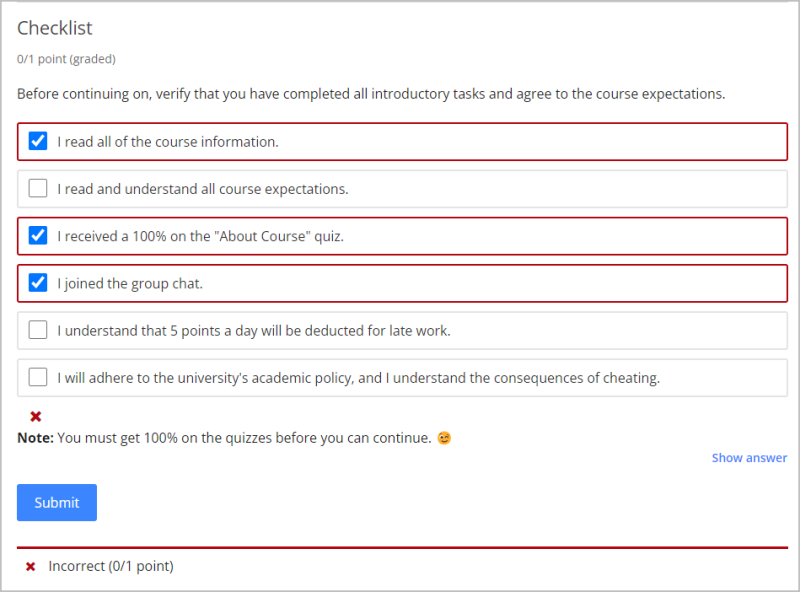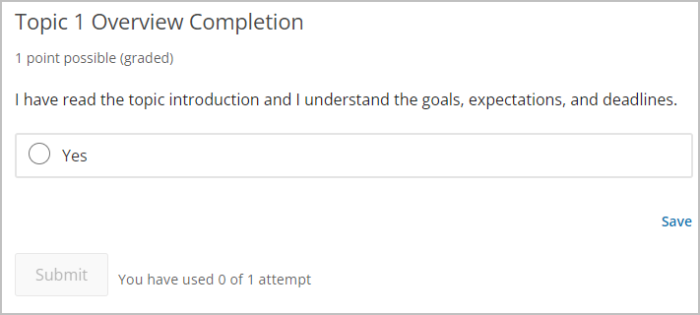Set Course Expecations
Objective: Ensure that your students read and understand the course expectations.
Your syllabus sets clear expectations for a face-to-face course. However, expectations might be different for an online course. Your students do not know what you expect from them or what they need to do in the online course. You should set clear expectations so that no one will be surprised at the end of the semester. You want to avoid the scenario where your students say, “they didn’t know that they had to do that (assignment, quizzes, etc.)”.
An ideal location for the course expectations is in the course introduction. Create a checkbox quiz with each expectation and then set it as a prerequisite to prevent the participants from continuing in the course until they confirm that they understand each expectation. All participants must understand and agree to the course expectations before they start the coursework. You will use this checklist as a prerequisite to access the first topic.
Create a Checklist
Here is how you can create a "graded checklist".
-
Edit the last page in your introduction topic.
-
Add a message asking them to verify that they understand all course expectations.
-
Add a new
Multiple Choiceproblem and call itChecklistor something similar. -
Have them acknowledge that they read all of the course information and expectations.
Tip: Add specifics so that there are no misunderstandings. For example:
✅I will log into the platform every week before Tuesday to read the weekly assignments.
✅I know my instructor's office hours and how to contact him. -
Make all questions the "correct" answer (they must agree to all course expectations before they can continue)

Recommended Course Expectations
Pseudo Attendance
There is no attendance in an online course. Students study a topic for a set duration instead of at a specific time, such as Monday to Sunday night. If you do not give requirements for learning online, your students will ignore the course entirely until the last week of the rating. An example of an expectation is that you expect all students to log in no later than Tuesday each week to read the announcements to understand the requirements for the week and to complete the assignments by the deadline. Will they do it? Once they know about your expectation, it becomes a matter of academic integrity. You then grade them accordingly.
One option to encourage them to read the announcements is to create a weekly check-in box worth 5% of the rating grade. It would be a simple quiz where you ask them to confirm that they read the topic announcements, introduction, and task list. You might consider including a question about the topic introcuction. The quiz would automatically close by a certain date, such as Tuesday night, to ensure the students get the points only if they checked in on time.
Simplest Confirmation:

Detailed Quiz:

Availability / Office Hours
Face-to-face courses have office hours when the instructor is available, but that concept doesn't work well with online courses. Instead, you should clearly state the times you are available for online consultations or when you have physical office hours. For example, you would be available to respond to students every day from 10:00-16:00, except on the weekend. Or, you might be in your office and also logged in to the real-time chat box on M-W-F from 10:00-12:00, where you will be available. Otherwise, you should be ready for them to send you messages or call you late at night, expecting you to respond.
Course Schedule and Deadlines
Online courses should have strict schedules and deadlines like traditional courses. Don’t expect the students to complete the work:
- If there are no deadlines
- 🤔Example: They assume they can hand in all assignments the day before the end of the rating.
- 💡Solution: All assignments must have a well-defined deadline.
- If you don't enforce the deadlines
- 🤔Example: They complained that they couldn’t complete the task on time because they were in the village, had a family event, had a broken computer, lost internet, had a friend visit, etc., etc.
- 💡Solution: Take off 5 points every day the assignment is late up to a maxim of 40 points (their maximum grade becomes 60/100), and do not accept submissions after two weeks late. They should be aware of deadlines and penalties in advance.
- If you give them unlimited opportunities
- 🤔Example: They submit a random PDF file hoping you will not look at it, and then you tell them to do it again. Then, they attempt the project on their own, but they do not show any effort. You ask them to do it again and then again until the rating ends.
- 💡Solution: While there is a benefit to giving additional opportunities, you need to be able to discern their effort. Grade the assignment as they give it to you. If they try and you think they can do better, give them another chance. Otherwise, give a zero or low grade when they deserve it (such as when they deliberately cheat or try to fool you). You only need to do it once (maybe twice with some students), and the student will learn.
- If there is no consequence for plagiarism
- 🤔Example: They submit an entire Wikipedia article or a classmate’s project, hoping you will give them a 95/100 for submitting something. You then ask them to do it themselves.
- 💡Solution: Submitting work that is not their own and claiming it as such (i.e., plagiarism) should receive an automatic zero. There can be no partial credit for plagiarism. If you give a zero once for plagiarism, they probably won’t do it a second time. At most universities, a second plagiarism incident means they automatically fail the course, and a third plagiarism incident results in expulsion from the university.
